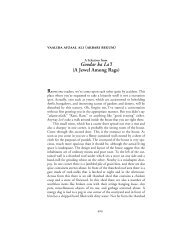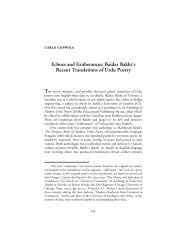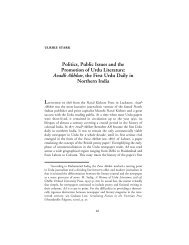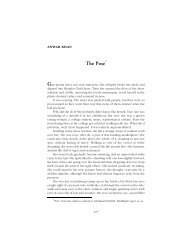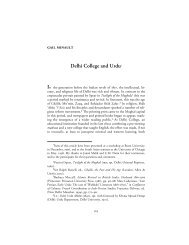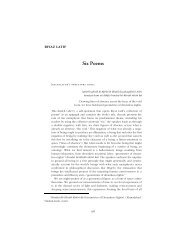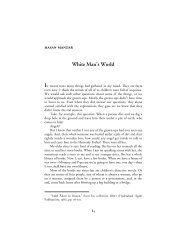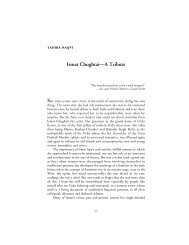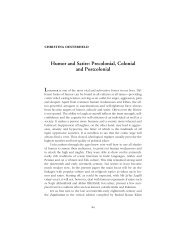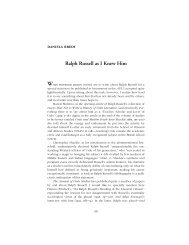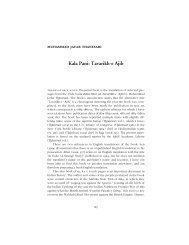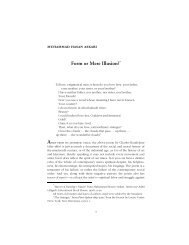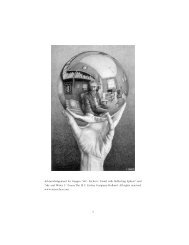Thesis Summary - the Annual of Urdu Studies
Thesis Summary - the Annual of Urdu Studies
Thesis Summary - the Annual of Urdu Studies
You also want an ePaper? Increase the reach of your titles
YUMPU automatically turns print PDFs into web optimized ePapers that Google loves.
256 • THE ANNUAL OF URDU STUDIESMuslims in India. An entirely different picture emerges from a novel byBismillah, where <strong>the</strong> religious symbolism <strong>of</strong> weaving is used as an illustration<strong>of</strong> asserted identity and as an aes<strong>the</strong>tic counterpart to <strong>the</strong> criticalsocial content <strong>of</strong> <strong>the</strong> novel.The writers share roots in <strong>the</strong> tradition <strong>of</strong> literary realism. This isreflected in a common aes<strong>the</strong>tic approach: depiction <strong>of</strong> reality that laysclaim to documentary truth, love <strong>of</strong> realistic detail, emphasis on everydaylife, and commitment to social <strong>the</strong>mes. The novels show a clear preferencefor scenic representation with its aes<strong>the</strong>tic effect <strong>of</strong> immediatenessand au<strong>the</strong>nticity; <strong>the</strong> influence <strong>of</strong> regionalism is noticeable in a concept <strong>of</strong>space limited to <strong>the</strong> representation <strong>of</strong> one’s own private sphere <strong>of</strong> experience,i.e., a specific microcosm. Apart <strong>the</strong>m <strong>the</strong>se similarities, however,considerable differences can be noted regarding <strong>the</strong> artistic expressivenessand <strong>the</strong> authors’ <strong>the</strong>oretical claim to <strong>the</strong> narrative structure <strong>of</strong> <strong>the</strong> novel.Specific novels are analyzed with a view to <strong>the</strong> aes<strong>the</strong>tic implications <strong>of</strong>compositional techniques and narrative discourse. Particular aspects thatare discussed include <strong>the</strong> aes<strong>the</strong>tically effective harmonization <strong>of</strong> contentand form, <strong>the</strong> extreme condensation <strong>of</strong> <strong>the</strong> time-space structure as aformal expression <strong>of</strong> existentialist concepts, <strong>the</strong> conceptualization <strong>of</strong> <strong>the</strong>time problem by means <strong>of</strong> an adequate discursive time structure, but also<strong>the</strong> lack <strong>of</strong> artistic dexterity in applying basic narrative techniques.Several novels serve as examples in <strong>the</strong> discussion <strong>of</strong> how specificnarrative perspectives and points <strong>of</strong> view are found suitable for <strong>the</strong> representation<strong>of</strong> reality and, especially, <strong>the</strong> treatment <strong>of</strong> identity as a literary<strong>the</strong>me. Multiple perspective conveyed through a combination <strong>of</strong>third-person narrative, interior monologue, direct speech and style indirectlibre appears as an effective device in <strong>the</strong> au<strong>the</strong>ntic and direct representation<strong>of</strong> a subjective world view. First-person narrative with its proximityto autobiography and inherent scope for self-reflection is shown to beespecially suited for <strong>the</strong> depiction <strong>of</strong> problematic or shattered identity. Aninteresting exception is <strong>the</strong> use <strong>of</strong> a self-conscious narrator in Raza’snovels, ironically pointing to <strong>the</strong> fictitiousness <strong>of</strong> <strong>the</strong> novel. Here, in acurious fashion, autobiographical identity problems fuse with fictionalidentity problems.The Hindi-<strong>Urdu</strong> controversy and <strong>the</strong> decline <strong>of</strong> <strong>the</strong> <strong>Urdu</strong> language,which represents an acute threat to <strong>the</strong> cultural identity <strong>of</strong> <strong>the</strong> Muslims innorth India, form <strong>the</strong> background for <strong>the</strong> discussion <strong>of</strong> <strong>the</strong> authors’ <strong>the</strong>oreticalstance in <strong>the</strong> language controversy, <strong>the</strong> use <strong>of</strong> language in <strong>the</strong>novels, and <strong>the</strong> treatment <strong>of</strong> language and identity as a <strong>the</strong>matic topic. AsMuslims who write in Hindi, <strong>the</strong> authors refute <strong>the</strong> widespread cliché



